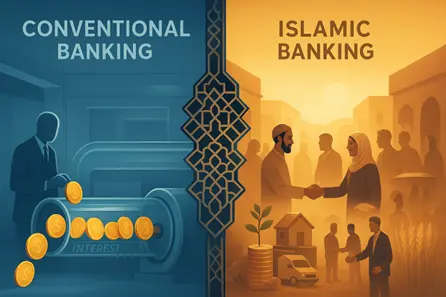


The banking system is often called the backbone of a country’s economy because it ensures a steady and reliable flow of capital that drives both growth and development. At first glance, commercial banks and Islamic banks may seem to serve the same purpose facilitating savings, investments, and financial transactions. However, the principles guiding their operations are very different.
In many Islamic countries, consumers are given two options: conventional commercial banks or Islamic banks. A common misconception is that the difference lies only in the name that Islamic banks work exactly like conventional ones but under a religiously compliant label. This blog clears that myth and explains the fundamental principles that make these two systems distinct.
The Core Divide: Interest (Riba) vs. Shariah Compliance
The most significant difference between commercial and Islamic banking lies in how they generate profits.
Commercial Banking: The Interest-Based Model
Conventional banks operate on an interest-based system (Riba), which is prohibited in Islam. The process is straightforward: banks accept deposits, provide loans, and charge interest on those loans. Their profit comes from the spread between the interest paid to depositors and the interest collected from borrowers. This return is fixed and guaranteed, regardless of whether the borrower succeeds or fails.
Islamic Banking: The Asset-Based and Ethical Model
Islamic banks, on the other hand, completely avoid interest. Instead, they operate on principles of Shariah compliance, focusing on risk-sharing, asset-backed financing, and ethical investments. Profits are earned through trade, investment in real assets, or partnerships—not by charging interest on money lent.
The Two Pillars of Islamic Financing: PLS and Non-PLS
Islamic banking offers a variety of financial products, broadly divided into Profit and Loss Sharing (PLS) and Non-PLS financing models.
This is considered the purest form of Islamic finance because both the bank and the customer share the risks and rewards.
Mudarabah (Trust-Based Partnership):
A partnership where the bank (Rabul Mal) provides capital and the entrepreneur (Mudarib) manages the business. Profits are shared as per agreement, but any financial loss is borne solely by the bank, while the entrepreneur loses only their effort and time.
Musharakah (Joint Venture):
Both the bank and the client contribute capital. Profits are shared according to a pre-agreed ratio (not necessarily based on capital contribution), but losses are divided strictly in proportion to each partner’s investment.
These modes offer fixed returns but remain Shariah-compliant because they are based on real assets and transparent contracts not on interest.
Conclusion: A Philosophical Divide
Although both systems provide essential financial services, their underlying philosophies differ greatly. Commercial banks thrive on debt and guaranteed returns, disconnected from the outcome of the borrower’s business. Islamic banks, however, promote equity, fairness, and shared responsibility.
Through models like Mudarabah and Musharakah (PLS) or Murabaha, Salam, Istisna, and Ijarah (non-PLS), Islamic banking ties finance directly to real economic activity. The word Islamic is not just a label. It represents a commitment to ethical, transparent, and risk-sharing financial practices. Understanding this difference empowers consumers to make choices that align not only with their financial goals but also with their values.



Dr. Haris Mehmood is a finance academic and professional with over 13 years of experience in teaching and industry. His expertise lies in modern finance principles, complemented by a deep interest in Islamic banking. By blending these perspectives, he provides clear insights into complex financial concepts. As a blogger and academic writer, Dr. Haris is committed to bridging knowledge gaps in finance and helping readers make informed decisions.
Please note that all opinions, views, statements, and facts conveyed in the article are solely those of the author and do not necessarily represent the official policy or position of Chaudhry Abdul Rehman Business School (CARBS). CARBS assumes no liability or responsibility for any errors or omissions in the content. When interpreting and applying the information provided in the article, readers are advised to use their own discretion and judgement.
If you are interested to write for CARBS Business Review Contact us!